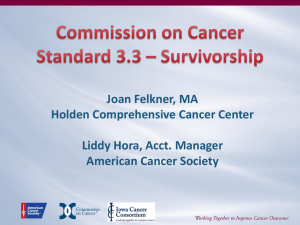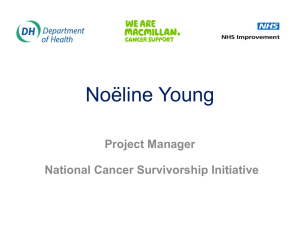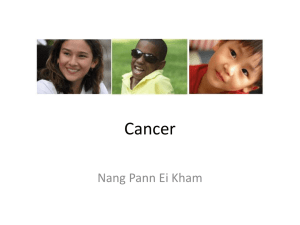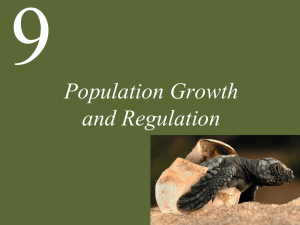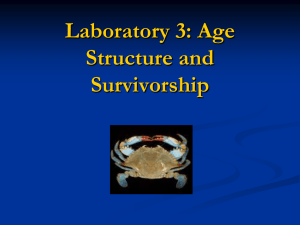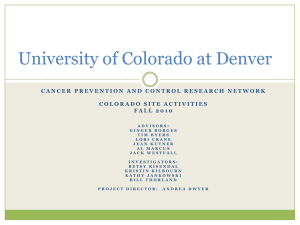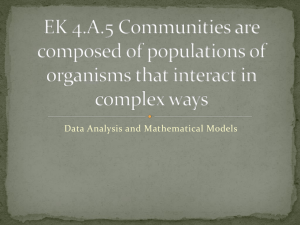MODULE 1 WELCOME TO MODULE 1 – CANCER SURVIVORSHIP
advertisement
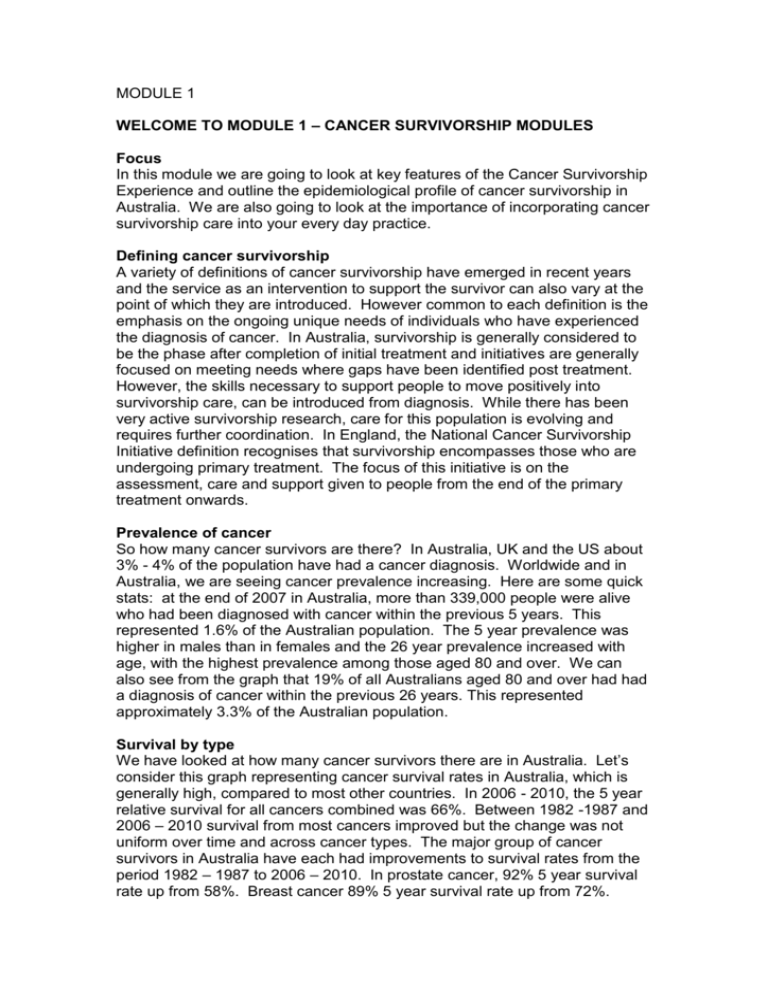
MODULE 1 WELCOME TO MODULE 1 – CANCER SURVIVORSHIP MODULES Focus In this module we are going to look at key features of the Cancer Survivorship Experience and outline the epidemiological profile of cancer survivorship in Australia. We are also going to look at the importance of incorporating cancer survivorship care into your every day practice. Defining cancer survivorship A variety of definitions of cancer survivorship have emerged in recent years and the service as an intervention to support the survivor can also vary at the point of which they are introduced. However common to each definition is the emphasis on the ongoing unique needs of individuals who have experienced the diagnosis of cancer. In Australia, survivorship is generally considered to be the phase after completion of initial treatment and initiatives are generally focused on meeting needs where gaps have been identified post treatment. However, the skills necessary to support people to move positively into survivorship care, can be introduced from diagnosis. While there has been very active survivorship research, care for this population is evolving and requires further coordination. In England, the National Cancer Survivorship Initiative definition recognises that survivorship encompasses those who are undergoing primary treatment. The focus of this initiative is on the assessment, care and support given to people from the end of the primary treatment onwards. Prevalence of cancer So how many cancer survivors are there? In Australia, UK and the US about 3% - 4% of the population have had a cancer diagnosis. Worldwide and in Australia, we are seeing cancer prevalence increasing. Here are some quick stats: at the end of 2007 in Australia, more than 339,000 people were alive who had been diagnosed with cancer within the previous 5 years. This represented 1.6% of the Australian population. The 5 year prevalence was higher in males than in females and the 26 year prevalence increased with age, with the highest prevalence among those aged 80 and over. We can also see from the graph that 19% of all Australians aged 80 and over had had a diagnosis of cancer within the previous 26 years. This represented approximately 3.3% of the Australian population. Survival by type We have looked at how many cancer survivors there are in Australia. Let’s consider this graph representing cancer survival rates in Australia, which is generally high, compared to most other countries. In 2006 - 2010, the 5 year relative survival for all cancers combined was 66%. Between 1982 -1987 and 2006 – 2010 survival from most cancers improved but the change was not uniform over time and across cancer types. The major group of cancer survivors in Australia have each had improvements to survival rates from the period 1982 – 1987 to 2006 – 2010. In prostate cancer, 92% 5 year survival rate up from 58%. Breast cancer 89% 5 year survival rate up from 72%. Melanoma of the skin, 91% 5 year survival rate up from 86%. Bowel cancer 66% 5 year survival rate up from 48%. Lung cancer, 14% 5 year survival rate up from 8.7%. For men, 5 year relative survival was highest for testicular cancer at 98%; lip cancer 93% and prostate cancer 92%. For women, 5 year relative survival is highest for thyroid cancer at 98%; melanoma of the skin at 95%; lip cancer of 92%. We also note the survival rates can vary according to a range of socio-demographic factors. 5 year relative survival was higher for people living in the least disadvantaged areas at 71% and lowest for people living in the most disadvantaged areas at 63%. Ageing population The Australian population is ageing. At the 30th June 2011, more than 3 million Australians – that’s 14% of the population – were aged 65 or over. By 2031, older Australians are projected to grow to 19% - 21% of the population. The number of people aged 85 and over is expected to more than double in the next two decades. What implications does this epidemiological data have for survivorship care? Click on the box below to reveal the answer Experience of a survivor Being a survivor means different things to different people. Some individuals report positive psycho-social effects including strength in relationships, a sense of gratitude or empowerment or an increased appreciation for life. What do you think are some of the common concerns that have been identified by survivors? Common survivor needs Survivors are at risk of experiencing distress associated with the range of physical, psychological, social or practical changes associated with survivorship. At least 50% of survivors suffer from some late effects of cancer treatment. Click below to reveal a summary of Potential Health Needs for Cancer Survivors. Specific issues Improved survival in some childhood cancers has resulted in a decline in mortality among children over the past decade. Click on the icon to show epidemiological data relating to childhood cancers. Common challenges experienced by child cancer survivors include: impact on growth; development and intellectual function; the development of second cancers; psycho-social problems; organ system impairment including cardio vascular disease, renal dysfunction, severe muscular skeletal problems and endocrine pathologies. Significantly it has been found that the incidence of chronic health conditions increases over time and does not appear to plateau. This adds further evidence to support the continued follow-up of childhood cancer survivors with an emphasis of surveillance for chronic conditions. Adolescents and young adults Common challenges experienced by adolescent and young adult cancer survivors include: long term physical impacts of cancer and its treatment which may include fatigue, pain, limb loss, impacts on fertility, cardiac and respiratory late effects and second malignancies; cognitive change which may be pronounced in the AYA life cycle which involve significant cognitive and neurological development; changed identity and challenges to the concepts of personal and social self uncertainty; anxiety; depression and other emotional impacts; challenges to body image and sexual identity; changed relationships; impacts on education and employment and financial and insurance restrictions. Click on the icon to reveal epidemiological data relating to adolescent and young adult cancers. Survival by age Cancer Survivorship care for the elder population, which we generally refer to as people 65 years and older, requires that attention be given to the expected late and long term effects of cancer and cancer treatments; as well as expected changes in health status that occurs with ageing. The following factors should be taken into account when assessing the older cancer survivors; functional status, co-morbidity, cognition, social support, psychosocial state, concomitant medications, nutrition, continence and carer support. Click to reveal the epidemiological data relating to cancers in older people. Summary In summary in this module we have looked at some of key features of cancer survivorship as an introduction. This has included a review of the epidemiological profile of cancer survivors in Australia. We have also begun to look at the health and support needs of cancer survivors as well as special issues for key population groups. In later modules, we look in more details at health and support needs of cancer survivors and how you as a clinician can assist cancer survivors in your care. We will also be looking at the crucial elements of how survivorship care can be incorporated into routine service delivery. Please now complete the Module 1 Quiz to test your knowledge. References 1 The next two slides contain the references that we used for the creation of this module. Thanks very much for listening.
